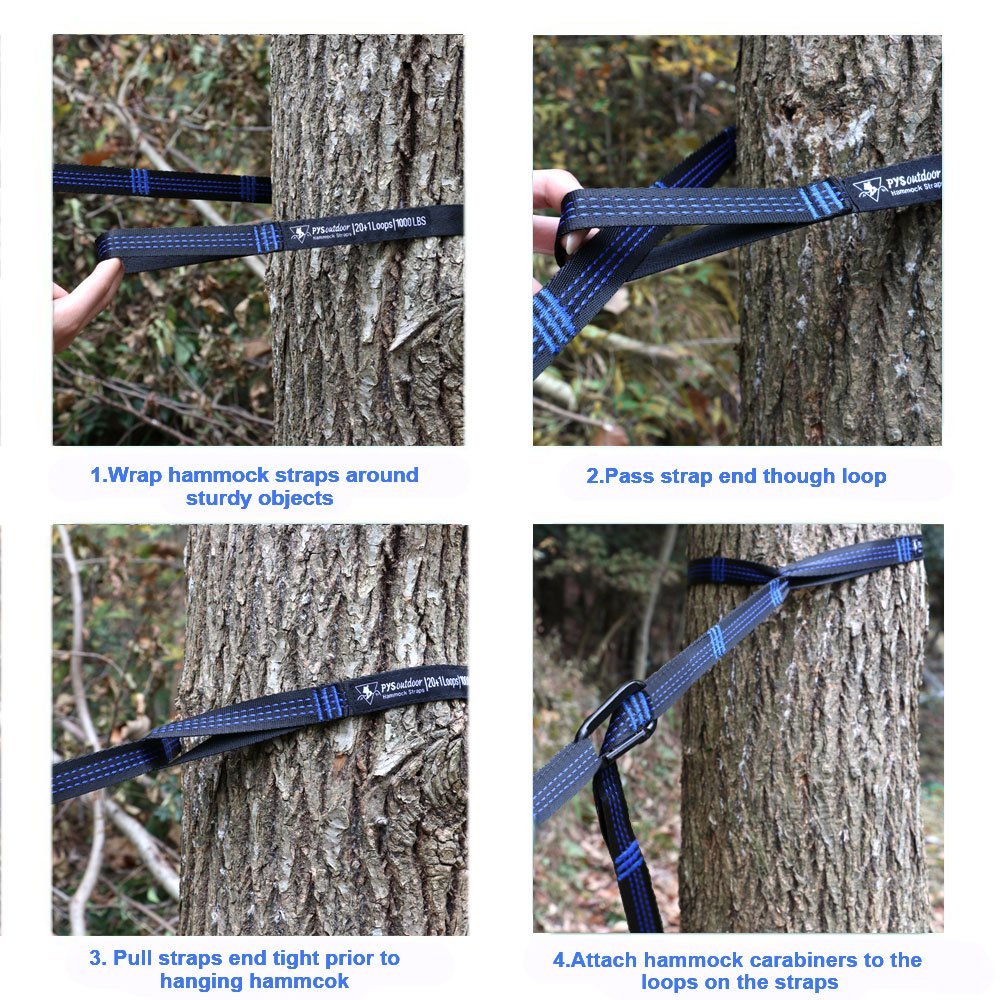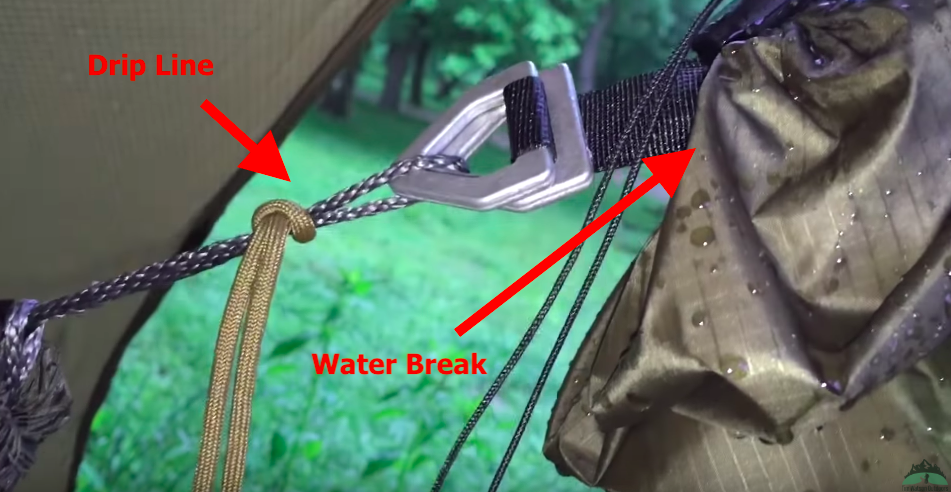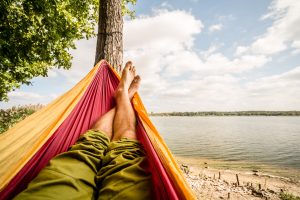There are few more comfortable ways to spend a night in the woods than in a hammock. You don’t have to sacrifice comfort for switching to a hammock. When done right, you can set up faster, pack lighter, and sleep better dangling between two trees.
This post is the compete guide to hammock camping. It is going to give you tips, show you exactly how set up your hammock for camping that is comfortable, safe, and warm.
Click to scroll to each section:
Setting Up Your Hammock
Setting up your hammock may seem a little daunting to some, but it isn’t! It is a pretty easy setup (usually easier than a tent), and you’ll get faster and faster the more you do it. Here we will give you a step by step guide (with tips) on how to set up your hammock for camping.
Find the Right Trees
When looking for trees to attach your hammock to, it is important that you are looking for sturdy trees that you won’t be harming by dangling between. Really any tree that you can strap onto, and it won’t bend, you are all set with. You’ll want to find two trees this sturdy that lie roughly 12-16 feet apart (3-4 meters).
You don’t want to damage the tree in any way, so it is also much better for the tree, and easier for your setup, if you are utilizing tree straps (directions on how to use are just below). They are cheap, and easy to get anywhere. Most are under $25.
Pro Tip: If you ever run into the situation where you are lacking trees (often at higher altitudes, beaches, or urban areas), you can use your hammock to camp without them! This may take some engineering if you are on a beach, in a place with boulders, or man made objects, but it is doable. There are also portable hammock stands that can be purchased.
Place Tree Straps on Tree
The tree straps should be placed around eye height. If the ground is not even next to the trees, you will be placing each tree strap at the same level, so that on uneven ground, they will be at different heights above the ground. It is very simple to wrap the strap around the tree and pass one end through the loop of the tree straps as seen below. Then campers will secure the strap to the hammock via rope or carabiner.

Setting Up Your Hammock Tarp (Optional – But Recommended)
Hammock rain flies are almost always simply just a tarp that is pulled over a tight line (ridgeline) between the two trees your hammock is hanging in between. The tarp should extend around 12 inches or more past each end of your hammock to prevent any rain from catching your hammock, and getting you wet at night. A 12 foot rain fly tends to suit almost all situations. The larger the fly, the better the weather prevention, but the more weight and size in your pack.
There are various shapes and sizes of rain flies for hammocks, all of which are very similar in setup and function. All are suspended over the hammock via a ridgeline with each edge of the tarp being pulled over the ride-line tightly so that the fly is tight, preventing any water build up. When rain isn’t expected the tarp can be spread out wide to allow for more air flow, and when precipitation is expected, campers can pull the rain fly to be tight to the hammock so that even rain in high winds won’t penetrate and get the hammock wet.
Using guylines attached to the ground, you can pull the ends of the tarp around the ridgeline and over the hammock. These guylines can be pulled tight close to the hammock, or spread further out depending on the amount of airflow and water protection you would like.
Pro Tip: A drip line, or water break, is a great way to avoid getting water flowing down your ridgeline and dripping on you in the middle of the night. Water will flow down your lines, and tying a small piece of rope at each end of your hammock will prevent water from flowing down the middle and ending up inside your setup. You can also wrap objects around the line that will break the flow of water down your line and to the hammock.

Here you see a great example of using the rain fly cover as a water break, and an extra piece of line as a drip line to stay dry during a rainy night.
Connecting Your Hammock to Your Straps
Once your rain fly is set up and your tree straps are securely on the tree, it is time to tie on your hammock ropes to the tree straps. This can be done via your knot of choice, or with carabiners.
It is important that your hammock isn’t too tight, or too saggy between the trees. When the hammock is too tight (the most common mistake), the hammock will pull the side walls very tight to your body, limiting your ability to make the hammock comfortable. This will also increase the potential damage to the tree and your hammock.
Hanging the hammock loose will allow you to set up in your hammock comfortable, and easily get in and out of the hammock. (We will go into more details further down)
Pro Tip: Tie a loop at the end of your hammock line so that a carabiner can easily be used to strap onto your tree straps. This may not work in all situations if your trees are situated at an unusual distance away, but having a loop already made can make the setup extremely fast.

Proper Hammock Angle
Getting Comfortable
Once you have your hammock set up properly, getting comfortable is easy. The ability to lay flat is crucial for staying comfortable all night. A common mistake is to tighten the hammock to make it more flat, which intuitively makes sense, but in practice, the hammock actually becomes less malleable, stiffer, and harder to lay flat.
When the hammock is loose, you will have the ability to lay at a slight diagonal (about 30 degrees). This is hugely beneficial to your ability to lay flat. This allows the pressure to be slightly relieved on your head and feet, and the most sturdy part of the hammock (the center) to support your main body mass. This angle allows you to lay flat more like on a bed than you could laying straight in the hammock.
When camping, you may also have a sleeping pad, and sleeping bag. A sleeping pad inside of your hammock can be a great way to maintain warmth, and add a little bit of padding on your hammock.
Pro Tip: If you have back issues, or you are having trouble getting comfortable in your hammock, you can try to lower the foot end of your hammock by bringing the tree straps of that end slightly down. Sometimes having the foot end of your hammock slightly lower can alleviate any discomfort in your back.

Having your feet and legs slightly to the left or right will allow your body to lay flatter on the hammock, making it more comfortable.
Hammock Camping In The Rain – Blocking The Weather
There is pretty much nothing better than laying in a hammock on a sunny and beautiful day, or a clear and starry night. When the weather goes bad, a hammock without a rain fly is no fun (I’ve been there) but when properly prepared, your hammock can be incredible, dry, and warm.

Pretty much any type of tarp can be used to block out precipitation, however rain flies made specifically for hammocking tend to be the most effective and easiest to set up.
There are also specific types of hammock covers that can be used in more severe weather. These covers can completely cover a hammock, and sometimes completely encase a hammock, almost creating a suspended tent that will fully block air flow and any type of precipitation. These types of covers are fantastic at blocking weather, but are slightly larger, heavier, and more difficult to set up than a basic tarp.
Pro Tip: A larger rainfly that can fully cover your hammock can actually be spread out and used to protect more than one hammock if you are camping in a group.
Blocking the Bugs
Worried about bugs? No problem, they also make bug nets designed specifically for hammock camping. Some hammocks come with bug nets attached to the hammock (known as a fixed bug net). These are great, however you cannot remove the bug net from the hammock, so in situations where you don’t want it, you’ll have to peel it back or flip your hammock over.
The most common option is a modular bug net. These can be purchased in various places. Here are some on Amazon. They can be a little pricey, but are super easy to set up, and will definitely keep the bugs out.
By simply slipping your hammock into the bug net, and strapping the bug net to your ridgeline, you will be able to keep the bugs out of your hammock while only adding a minute or two to your hammock setup. There is no issue using these systems with the rain fly as well.
Pro Tip: Don’t sleep bare back on the hammock in buggy situations. They can get you through the hammock!
Staying Warm
Sleeping while shivering isn’t fun, so here are some tips to keep you warm in your hammock. Unless you are in a tropical rainforest with a really warm night ahead of you, you’ll likely be cold.
One great setup is basically the same setup that you should use in a tent: a sleeping pad, and a sleeping bag.
The sleeping pad is crucial to preventing loss of heat from the bottom of the hammock. The same effect happens on the ground. Not only do pads provide softness for your back, but they prevent the compression of your bag, and capture heat close to the body. Inflatable pads, or foldable pads work great here. Check out our guide to choosing a sleeping pad, or shop for some on Amazon. They even make sleeping pads specifically for hammocks.
Some seasoned hammock campers choose to stay warm with top quilts and under quilts for your setup. This is an extremely effective and comfortable option for staying warm. These come in down (usually the best quality) and synthetic materials. The synthetic materials do however usually tend to stay better insulated when wet.
The top quilt acts much like a sleeping bag, and the camper can use this as a blanket, or as a sleeping bag. The bottom quilt wraps around the bottom of the hammock on the outside. This acts as an insulating layer to the hammock. By being on the outside of the hammock, it doesn’t get compressed, and therefore can provide the insulation from the bottom to keep the warmth in.
You can shop for top quilts and bottom quilts on Amazon.
Pro Tip: If you are a camper looking to try out hammock camping, start out with a sleeping pad and bag combo (that you already used in your tent camping) to see how hammock camping feels. This will allow you to spend little extra money to test it out.
Shop For Hammock Top Quilts Here
Shop For Hammock Bottom Quilts Here
Hammock Vs. Tent Camping: Pros & Cons
Comfort
Comfort is a bit subjective. Hardcore hammock campers will tell you that you can be just as comfortable, if not more comfortable in a hammock. While this is the case for some people, generally it is usually a little easier to be comfortable in a tent pending you can find some flat ground and have a good sleeping pad and bag setup. It is hard to give either a hammock or a tent a win in this situation. Our best recommendation is to test out both methods in various scenarios, and see what suits your style. Testing things out in your backyard can be quite helpful.
Ease of Setup
Some tents are SO easy to set up. Some tents are very difficult. Both hammock and tent setups can be complex and easy, it is really just a matter of equipment, weather conditions, and your location. In perfect weather, not much is easier than a hammock.
Bad Weather
When it comes to bad weather, tenting is usually a more comfortable option. Setting up in high winds and rain is honestly pretty difficult for both setups. Overall, tent camping is probably more ideal in severe weather conditions. Both are also suitable for cold and hot situations.
Versatility
Both hammock and tent camping have pros and cons when it comes to versatility. Hammocks can be used where there isn’t flat ground, they can be used for just chilling by the water, or for non camping situations, or even for chairs. Hammocks however are limited to having trees be available. On mountain tops or certain climates, this can occasionally be a big problem. Tents work wherever there is flat ground, and they can make by on non-flat ground (though you probably won’t be comfortable).
Was this post helpful? If so, let us know! Does it need more added to it? Let us know that, too!
Max DesMarais is the founder of hikingandfishing.com. He has a passion for the outdoors and making outdoor education and adventure more accessible. Max is a published author for various outdoor adventure, travel, and marketing websites. He is an experienced hiker, backpacker, fly fisherman, backcountry skier, trail runner, and spends his free time in the outdoors. These adventures allow him to test gear, learn new skills, and experience new places so that he can educate others. Max grew up hiking all around New Hampshire and New England. He became obsessed with the New Hampshire mountains, and the NH 48, where he guided hikes and trail runs in the White Mountains. Since moving out west, Max has continued climbed all of the Colorado 14ers, is always testing gear, learning skills, gaining experience, and building his endurance for outdoor sports. You can read more about his experience here: hikingandfishing/about
